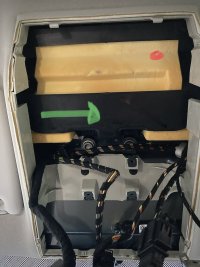D
Dergolf
Hello from Denmark!
T5 California 2006:
I have just now replaced both hydraulic rams after one was exploded. (it had pushed the bottom end cap off, in sunny spain)
Lost a lot of fluid there.
So i replaced both rams.
First try after replacment i could only open the roof about 20%.
So i could not figure out to remove the headliner here and now.
So i used the ram i removed to pump new hydraulic fluid in the system. Like a bicycle air pump. Also one stroke before it get very tight.
Did it first one the "exploded" side.
The roof now could open about 70%.
Did the same thing one the other side. But not much fluid could i press in.
Now the roof opens about 80 %.
I'm pretty sure the system need more fluid.
I think i have to remove the headliner for get to the reservoir.
I found a thread about it

 vwcaliforniaclub.com
vwcaliforniaclub.com
There a some things i don't understand in this tread.:
Then you unscrew the top bed light, loosen the felt tape on the runner, drill out 2 rivets on both sides and lift up the sliders (after opening the roof). Just drill out the heads, and leave the rest of the rivets in place. So you can clip on and off the headlining, in case you should need to remove the headlining again later (like I did because of a pinched out water drain):
What is felt tape?
What is the runner?
Where a the rivets who needs to get drilled out?
Sliders?
Please explain.....
Sincerely...
Michael
T5 California 2006:
I have just now replaced both hydraulic rams after one was exploded. (it had pushed the bottom end cap off, in sunny spain)
Lost a lot of fluid there.
So i replaced both rams.
First try after replacment i could only open the roof about 20%.
So i could not figure out to remove the headliner here and now.
So i used the ram i removed to pump new hydraulic fluid in the system. Like a bicycle air pump. Also one stroke before it get very tight.
Did it first one the "exploded" side.
The roof now could open about 70%.
Did the same thing one the other side. But not much fluid could i press in.
Now the roof opens about 80 %.
I'm pretty sure the system need more fluid.
I think i have to remove the headliner for get to the reservoir.
I found a thread about it

As promised: Changing the electrohydraulic roof pump!
So as I promised last year, I wanted to keep you updated about changing the electrohydraulic roof pump. Therefore we need: a pump, some guts, a bit of spare time, and some helping hands. Up to now I only have the pump and the headlining taken off. First we take off the A-pillar handles...
There a some things i don't understand in this tread.:
Then you unscrew the top bed light, loosen the felt tape on the runner, drill out 2 rivets on both sides and lift up the sliders (after opening the roof). Just drill out the heads, and leave the rest of the rivets in place. So you can clip on and off the headlining, in case you should need to remove the headlining again later (like I did because of a pinched out water drain):
What is felt tape?
What is the runner?
Where a the rivets who needs to get drilled out?
Sliders?
Please explain.....
Sincerely...
Michael






























